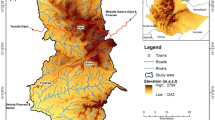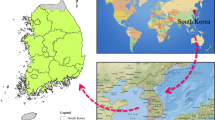Abstract
Accelerated soil erosion degrades soil quality and undermines ecosystem functions and services. It is important to assess the severity of erosion, demarcate tolerable limits for sustainable crop production, conservation planning for soil resources, and identify the alternative land uses. Irrespective of soil type, climate and vegetation cover, the tolerable level of soil erosion in India has traditionally been taken as 11.2 Mg ha−1 year−1. However, this is an excessive rate for most agro-ecosystems and land uses; hence, this study aims to establish credible soil loss tolerance (‘T’ values) for some soils of western India on the basis of critical soil parameters (i.e., bulk density, infiltration rate, total organic carbon and soil reaction). The condition of a soil or ‘soil state’ (S) is defined through a quantitative model involving different soil functions. The ‘T’ values for some soils of western India ranged between 2.5 and 12.5 Mg ha−1 year−1 compared to default ‘T’ value of 11.2 Mg ha−1 year−1. About 50% of the land area has ‘T’ value >10 Mg ha−1 year−1, and the remaining 50% has <7.5 Mg ha−1 year−1, of which 13.02 M ha is having only ‘T’ value of 2.5 Mg ha−1 year−1. Using the revised ‘T’ values for soil mapping units will help in planning of appropriate conservation measures for effective erosion control, sustainable crop production and improved watershed management in the Rajasthan State of western India.


(Source: ICAR - Indian Institute of Soil and Water Conservation, Dehradun)
Similar content being viewed by others
References
Andrews SS, Karlen DL, Mitchell JP (2002) A comparison of soil quality indexing methods for vegetable production systems in northern California. Agric Ecosyst Environ 90(1):25–45
Andrews SS, Mitchell JP, Mancinelli R, Karlen DL, Hartz TK, Horwath WR, Pettygrove GS, Scow KM, Munk DS (2002) On farm assessment of soil quality in California’s central valley. Agron J 94(1):12–23
Arshad MA, Lowery B, Grossman RB (1996) Physical tests for monitoring soil quality. In: Doran JW and Jones AJ (eds) Methods of assessing soil quality. Soil Science Society of America Special Publication, vol 49. Soil Science Society of America, Madison, pp 123–141
Beach T, Gersmehl P (1993) Soil erosion, ‘T’ values and sustainability: a review and exercise. J Geogr 92(1):16–22
Burrough PA, MacMillan RA, Deursen WV (1992) Fuzzy classification methods for determining land suitability from soil profile observations and topography. J Soil Sci 43:193–210
Cole GW, Higgins JJ (1985) A probability criterion for acceptable soil erosion. Trans ASAE 28(6):1921–1926, 1932 and 1985
DLWC (Department of Land and Water Conservation) (1997) Soil and Landscape issues in environmental impact assessment. Technical Report No. 34, DLWC, Sydney
Doran JW, Parkin TB (1994) Defining and assessing soil quality. In: Doran JW et al (eds) Defining soil quality for a sustainable environment. Soil Science Society of America Special Publication, vol 35. Soil Science Society of America, Madison, Wisconsin, pp 3–21
Grossman RB, Harms DS, Seybold CA, Herrick JE (2001) Coupling use dependent and use-invariant data for soil quality evaluation in the United States. J Soil Water Conserv 56(1):63–68
Gupta JP (1990) Sand dunes and their stabilization. In: Abrol IP, Dhruvanarayana VV (eds) Technologies for wasteland development. ICAR, New Delhi, pp 59–68
Hall GE, Logan TJ, Young KK (1985) Criteria for determining tolerable erosion rates. In: Follet RF, Stewart BA (eds) Soil erosion and crop productivity. American Society of Agronomy, Madison
Harris RE, Karlen DI, Mulla DJ (1996) A conceptual framework for assessment and management of soil quality and health. In: Doran JW, Jones AJ (eds) Methods for assessing soil quality. Soil Science Society of America Special Publication, No. 49, SSSA, Madison, pp 61–82
International Soil Science Society, ISSS (1996) Terminology for soil erosion and conservation. Grafisch Service Centrum, Wageningen
Karlen DL, Stott DE (1994) A framework for evaluating physical and chemical indicators of soil quality. In: Doran JW et al (eds) Defining soil quality for a sustainable environment. Soil Science Society of America Special Publication, No. 35. SSSA, Madison, pp 53–72
Kaul RN (1985) Afforestation of dune areas. In: FAO (ed) Sand dune stablization, shelterbeds and afforestation in dry zones. FAO Conservation Guide, Rome, pp 75–85
Kok K, Clavaux MBW, Heerebout WM, Bronveld K (1995) Land degradation and land cover change detection using low-resolution satellite images and the CORINE database: a case study in Spain. ITC J 3:217–227
Lakaria BL, Mandal D, Biswas H (2008) Soil loss tolerance values for different physiographic regions in Central India. Soil Use Manag 24(2):192–198
Lal R (1988) Monitoring soil erosion’s impact on crop productivity. In: Lal R (ed) Soil erosion research methods. Soil and Water Conservation Society, Ankeny, pp 187–202
Lal R (1996) Methods and guidelines for assessing sustainable use of soil and water resources in the tropics. Scientific Publishers, Jodhpur
Larson WE, Piece FJ (1991) Conservation and enhancement of soil quality. In: Dumanski J et al (eds) Evaluation for sustainable land management in the developing world. Technical papers, proceedings of international workshop, Chiang Rai, Thailand. International Board for Soil Research and Management, Bangkok, pp 175–203
Lenka NK, Mandal D, Lenka S, Sudhiri S (2013) Soil loss tolerance limit for different physiographic regions of Odhisha. J Ind Soc Soil Sci 61(4):293–299
Maji A (2007) Assessment of degraded and wastelands of India. J Ind Soc Soil Sci 55(4):427–435
Mandal D, Sharda VN (2011) Assessment of permissible soil loss in India employing a quantitative bio-physical model. Curr Sci 100(3):383–390
Mandal D, Dadhwal KS, Khola OPS, Dhyani BL (2006) Adjusted ‘T’ values for conservation planning in Northwest Himalayas of India. J Soil Water Conserv 61(6):391–397
Mannering JV (1981) The use of soil loss tolerance as a strategy for soil conservation. In: Morgan RPC (ed) Soil conservation: problems and prospects. Wiley, New York
McBratney AB, Odeh IOA (1997) Application of fuzzy sets in soil science: fuzzy logic, fuzzy measurements and fuzzy decisions. Geoderma 77:85–113
McCormack DE, Young KK, Kimberlin LW (1982) Current criteria for determining soil loss tolerance. In: Schmidt BL et al (eds) Determinants of soil loss tolerance. Agronomy Society of America Special Publication No. 45, Madison
Nearing MA, Ascough DL, Latlen JM (1990) Sensitivity analysis of the WEPP hill slope profile erosion model. Trans ASAE 33:839–849
Piemental D, Terhune E, Dyson Hudson R, Rocherean S, Samis R, Smith EA, Denman D, Neider DR, Shepard M (1976) Land degradation: effect on food and energy resources. Science 194:149–155
Pretorius JR, Cooks J (1989) Soil loss tolerance limits: an environmental management tool. GeoJournal 19:67–75
Renschlor CS, Harbor J (2002) Soil erosion assessment tools from point to regional scales: the role of geomorphologists in land management research and implementation. Geomorphology 47(2):189–209
Soil Conservation Society of America (1982) Resource conservation glossary. 3rd edn. Soil Conservation Society of America, Ankeny, USA, p 193
Ringo DE (1999) Assessment of erosion in the Turasha catchment in the lake Naivasha area, Kenya. M.Sc. Thesis, Enschede, Kenya
Schertz DL, Nearing M (2006) Erosion tolerance/soil loss tolerance. In: Lal R (ed) Encyclopedia of soil science. Taylor and Francis, London. doi:10.1081/E-ESS-120042864
Sharda VN, Mandal D, Ojasvi PR (2013) Identification of soil erosion risk areas for conservation planning in different states of India. J Environ Biol 34:219–226
Singh RK, Singh RS, Singh KD, Shyampura RL (2005) Soil erosion map of Eastern Rajasthan. Ind J Soil Conserv 33(2):118–122
Skidmore EL (1982) Soil loss tolerance. In: Schmidt BL (ed) Determinants of soil loss tolerance. ASA Special Publication No. 45, pp 87–93
Sys C (1985) Land evaluation: part I. University of Ghent, Ghent
USDA-NRCS (1999) National soil survey handbook. US Government Printing Office, Washington, DC
USDA-SCS (1973) Advisory notice, soil-6. US Government Printing Office, Washington, DC
Verma BS, Chinnamani SN, Bhola Rao DH, Prasad SN, Prakash C (1986) Twenty-five years of research on soil and water conservation in ravine lands of Rajasthan. Central Soil and Water Conservation Research and Training Institute, Research Centre Publication, Kota
Wischmeier WH, Smith DD (1978) Predicting rainfall erosion losses: a guide to conservation planning. U.S. Department of Agriculture. Agricultural Handbook, vol 537. USDA, Washington, DC, p 85
Wymore AW (1993) Model based systems engineering: an introduction to the mathematical theory of discrete systems and to the tricotyledon theory of system design. CRC Press, Boca Raton
Acknowledgements
We are highly grateful to Dr. V.N. Sharda, Member (ASRB) and Former Director, ICAR-IISWC (formerly CSWCRTI), Dehradun, India, for his guidance and thought provoking suggestions in taking up this study for western India. Help rendered by various research organizations is duly acknowledged. We sincerely thank Editor-in-Chief and Anonymous reviewers for their constructive comments and suggestions that has tremendously improved the quality of the manuscript.
Author information
Authors and Affiliations
Corresponding author
Rights and permissions
About this article
Cite this article
Singh, R.K., Somasundaram, J., Lakaria, B.L. et al. Using Credible Soil Loss Tolerance Value for Conservation Planning and Managing Diverse Physiographic Regions in Rajasthan. Agric Res 6, 169–178 (2017). https://doi.org/10.1007/s40003-017-0248-8
Received:
Accepted:
Published:
Issue Date:
DOI: https://doi.org/10.1007/s40003-017-0248-8




